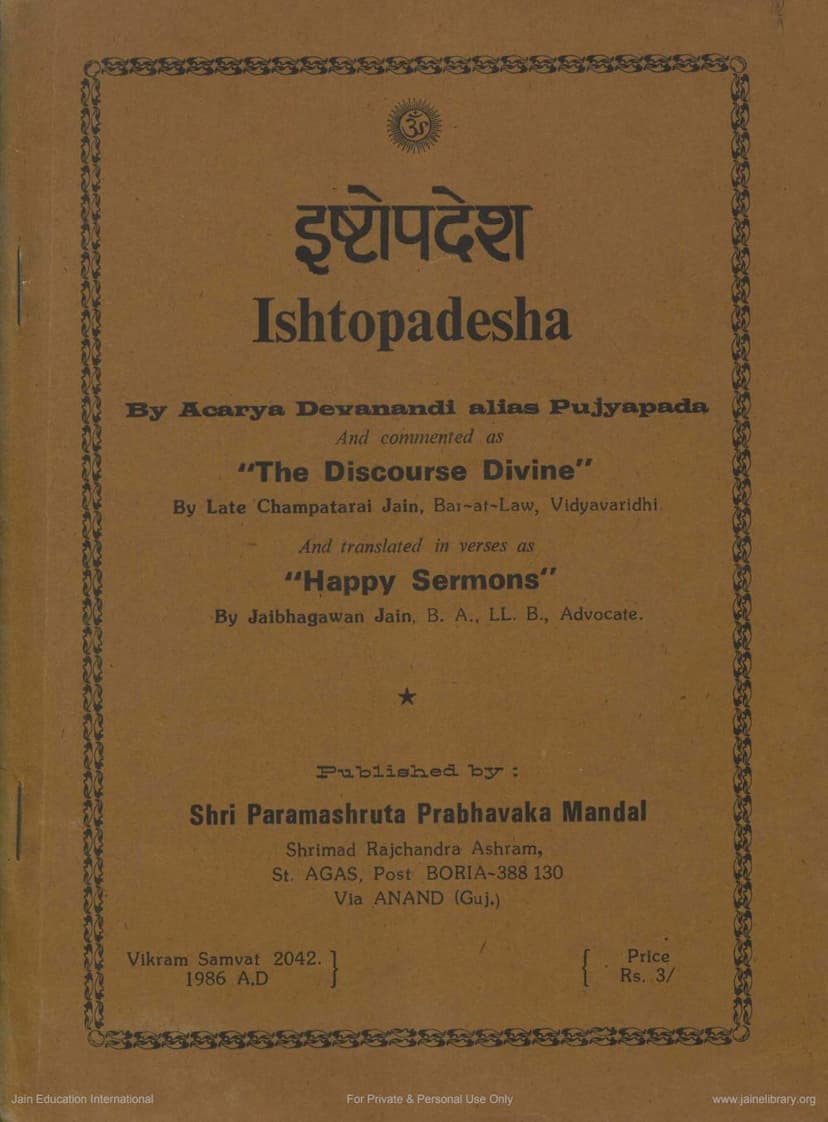Ishtopadesha
Added to library: September 1, 2025

Summary
Here's a comprehensive summary of the Jain text "Ishtopadesha" by Acarya Devanandi (also known as Pujyapada Swami), based on the provided document:
Title: Ishtopadesha (also translated as "The Discourse Divine" or "Happy Sermons")
Author: Acarya Devanandi (Pujyapada Swami)
Commentator/Translator: Late Champatarai Jain (Commentary), Jaibhagawan Jain (Versified Translation)
Publisher: Shri Paramashruta Prabhavaka Mandal
Overall Theme: The "Ishtopadesha" is a spiritual and philosophical treatise that guides the reader towards self-realization, liberation (moksha), and the attainment of true happiness. It emphasizes the importance of understanding the distinction between the self (soul) and the not-self (matter), the transient nature of worldly pleasures and possessions, and the path of inner contemplation and self-discipline.
Key Concepts and Teachings:
-
The True Nature of the Soul (Self):
- The soul is intrinsically pure, blissful, and omniscient.
- It is eternal and unaffected by death, disease, or the changes of life (childhood, youth, old age).
- The soul's true nature is its inherent divinity, which is obscured by ignorance and the influence of matter.
-
The Illusion of the Not-Self:
- The physical body, wealth, relationships, and all worldly possessions are temporary and ultimately separate from the soul.
- Attachment to these external things leads to suffering and prolongs the cycle of birth and death (samsara).
- Worldly pleasures are fleeting and often lead to more pain and dissatisfaction, akin to a fever patient consuming ghee.
-
The Path to Liberation (Moksha):
- Self-Contemplation (Dhyana/Meditation): The primary means to realize the self is through focused introspection and meditation, withdrawing the senses from external objects.
- Discrimination (Viveka): Clearly understanding the difference between the soul (Self) and matter (not-Self) is crucial. This distinction is considered the quintessence of all wisdom.
- Equanimity (Samata): Maintaining a balanced mind, unaffected by honor or disgrace, pleasure or pain, is essential.
- Renunciation (Tyaga): Detaching oneself from worldly desires and possessions, and controlling the activities of mind, speech, and body, are necessary steps.
- Self-Discipline and Vows (Samyama/Vrata): Observance of vows and self-discipline, though sometimes appearing arduous, are vital for purifying the soul and preventing descent into lower realms of existence.
- Right Faith and Right Knowledge: Cultivating unwavering faith in the Self and acquiring true knowledge about its nature are the cornerstones of spiritual progress.
-
Ignorance as the Root Cause of Suffering:
- Ignorance (avidya) of the soul's true nature and attachment to the ephemeral world are the primary causes of bondage and suffering.
- Infatuation, likes, and dislikes cloud judgment and prevent the soul from realizing its inherent perfection.
-
The Cycle of Karma:
- Actions (karma) create further karma, perpetuating the cycle of transmigration.
- The soul is bound by karmic forces due to its attachments and aversions.
- Through spiritual practice, one can stop the influx of new karma (asrava) and destroy existing karma (nirjara), leading to liberation.
-
The Role of the Guru and Self:
- While external teachers and scriptures can guide, the ultimate teacher and guide is the soul itself, as it possesses the inherent capacity for self-realization.
- The effort for liberation must come from within the individual.
-
The Nature of Divine Bliss:
- True happiness (ananda) is not derived from external objects but is an inherent attribute of the soul.
- As one progresses in self-realization, worldly desires diminish, and the experience of inner bliss increases.
Structure and Style: The "Ishtopadesha" is composed of Sanskrit verses (shlokas), which are aphoristic and philosophical. The provided document includes the original Sanskrit text, a detailed commentary and explanation, and a versified English translation. The verses often use analogies and metaphors to illustrate complex spiritual concepts, such as the comparison of the impure soul to ore that can become gold.
Target Audience: The text is intended for seekers of truth and liberation (mumukshu), those who are aspiring for spiritual growth and a deeper understanding of life and the soul.
Core Message: The central message of the "Ishtopadesha" is that true and lasting happiness lies not in the external world but within the self. By understanding the self's divine nature, detaching from the illusions of matter, and diligently pursuing self-contemplation, one can achieve liberation from suffering and attain eternal bliss. The book serves as a guide to this path, offering wisdom and encouragement to the spiritual aspirant.